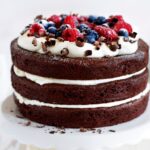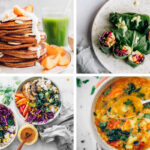Imagine a freezer stocked with vibrant, flavorful, allergen-free meals, ready to conquer even the busiest weeknights. No more frantic searches for last-minute dinners or compromises on dietary needs. This guide unveils the secrets to transforming your kitchen into a haven of stress-free, healthy eating, offering a step-by-step approach to planning, preparing, freezing, and reheating delicious allergen-free meals. Picture the ease of pulling a perfectly portioned, nutritious dinner from the freezer, ready to be reheated in minutes—a culinary time-saver that doesn’t compromise on taste or health.
We’ll explore detailed recipe planning, mastering food preparation techniques for optimal freezer storage, and safe thawing and reheating methods. Learn how to avoid common pitfalls like freezer burn and maintain the quality and deliciousness of your meals. Through practical tips and easy-to-follow recipes, you’ll gain the confidence to create a freezer full of healthy, convenient, and allergen-free meals, ensuring stress-free evenings and satisfying meals for weeks to come. Prepare to transform your weeknight routine with this comprehensive guide.
Proper Food Preparation Techniques for Freezing
Preparing allergen-free meals for freezing requires careful attention to detail to maintain both quality and safety. Proper techniques ensure your hard work translates into delicious, convenient meals later. This involves selecting the right ingredients, employing appropriate cooking methods, and utilizing suitable packaging to prevent freezer burn and maintain nutritional value.
The key to successful freezer meal preparation lies in minimizing moisture content and maximizing the protection of your carefully crafted dishes. This prevents ice crystal formation, which can alter texture and flavor upon thawing. By following these steps, you can create a freezer-friendly arsenal of allergen-free meals ready for those busy weeknights.
Pre-Freezing Cooking Methods
The cooking method you choose significantly impacts the final frozen product’s quality. Certain methods are better suited for freezing than others. For instance, stir-fries often lose their crispness after freezing, while stews and soups tend to freeze remarkably well.
For best results, aim to cook your allergen-free meals until they are just barely cooked through before freezing. This prevents overcooking during the reheating process. This is particularly important for vegetables, which can become mushy if overcooked before or after freezing. For example, a vegetable stir-fry should be cooked until tender-crisp, not completely soft, before being portioned and frozen. Similarly, pasta should be cooked al dente prior to freezing to avoid a gummy texture upon thawing. Meats should be cooked to a safe internal temperature before freezing to prevent bacterial growth.
Portioning and Packaging for Optimal Freezer Storage
Proper portioning and packaging are critical for maximizing freezer space and minimizing freezer burn. Freezer burn, caused by ice crystals forming on the surface of the food, compromises texture and flavor. Using airtight containers is paramount to preventing this. The ideal container size depends on your household needs; however, individual or family-sized portions are generally recommended for convenience.
Imagine a neatly organized freezer, filled with uniformly sized containers. Each holds a single-serving portion of a delicious, allergen-free meal. These are clearly labeled with the date and contents, making meal selection quick and easy. This visual organization minimizes food waste and maximizes efficiency. Consider using freezer-safe bags for flatter items, such as individual servings of sauce or flatbreads, to maximize space.
Labeling for Easy Identification and Reheating
Clear and comprehensive labeling is essential for efficient freezer management and safe reheating. Each container should be labeled with the recipe name, the date of freezing, and reheating instructions. This information ensures that you can easily identify and use your frozen meals without guesswork. Using a permanent marker on freezer-safe tape or labels prevents smudging or fading.
A well-labeled container might look like this: A clear, rectangular container holds a vibrant-looking lentil stew. A piece of freezer-safe tape across the top displays the following information in bold, black marker: “Lentil Stew – 10/26/2024 – Reheat gently on stovetop or in microwave until heated through.” The clear container allows for visual identification of the contents, while the label provides all necessary information for easy and safe use. This level of detail reduces confusion and ensures that your frozen meals are easily accessible and enjoyable.
Safe Freezing and Thawing Procedures
Freezing allergen-free meals correctly ensures both food safety and the preservation of taste and texture. Proper techniques minimize the risk of bacterial growth and maintain the nutritional value of your carefully prepared dishes. This section details the best practices for freezing and thawing, emphasizing safe temperature control and appropriate packaging choices.
Freezing Prepared Meals
To achieve optimal freezing results, begin by portioning your allergen-free meals into freezer-safe containers. Imagine vibrant, colorful curries nestled in sturdy, clear plastic containers, allowing for easy identification. Or picture individual servings of hearty stews, each sealed tightly in a reusable silicone mold. Leave about an inch of headspace at the top of each container to allow for expansion during the freezing process. This prevents spills and maintains the integrity of the meal. For even faster freezing, consider using shallow, wide containers. Label each container clearly with the contents and the date, using a permanent marker. This simple step ensures easy identification and helps you manage meal rotation effectively. Finally, place the containers in the freezer, ensuring they are not overcrowded to allow for proper air circulation. Aim for a freezer temperature of 0°F (-18°C) or below for optimal food safety.
Thawing Methods and Their Impact
Three primary methods exist for thawing frozen allergen-free meals: refrigeration, microwave, and cold water. Refrigerator thawing is the safest method, gradually raising the food’s temperature over several hours or overnight. This slow thaw minimizes the risk of bacterial growth and preserves the food’s texture and quality. Imagine the gentle transition of a frozen lasagna from solid to pliable, its layers remaining intact and its flavors undisturbed. Microwave thawing offers speed and convenience, but it can lead to uneven heating and potentially affect the texture of some foods. Picture a rapidly thawing casserole, where some parts might become overly warm while others remain icy. This uneven heating increases the risk of bacterial growth in the cooler areas. Cold water thawing involves submerging the sealed container in cold water, changing the water every 30 minutes to maintain a consistently low temperature. This method is faster than refrigeration but slower than the microwave, offering a balance between speed and safety. Imagine a sealed bag of soup gently warming in a bowl of ice water, its contents remaining evenly chilled until ready to be reheated.
Safe Reheating Techniques
Proper reheating is crucial for ensuring both food safety and maintaining the quality of your allergen-free meals. Always reheat your meal thoroughly to an internal temperature of 165°F (74°C). This eliminates any potential harmful bacteria. This can be achieved using various methods: microwave ovens, stovetops, or ovens. When using a microwave, ensure the food is heated evenly by stirring it halfway through. For stovetop or oven reheating, use low to medium heat, ensuring the food reaches the safe internal temperature throughout. Avoid reheating food multiple times, as this can degrade its quality and increase the risk of bacterial growth. Remember, proper reheating is the final step in ensuring your previously frozen allergen-free meals remain safe and delicious.
Recipe Examples

These allergen-free recipes provide delicious and safe meal options for individuals with dietary restrictions. Each recipe is designed for easy preparation and freezing, ensuring convenient and healthy meals throughout the week. Remember to always double-check ingredient labels to confirm they are free from your specific allergens.
Allergen-Free Chicken Stir-Fry
This vibrant and flavorful chicken stir-fry is naturally free from common allergens like gluten, dairy, soy, and nuts. The recipe focuses on fresh vegetables and lean protein, creating a healthy and satisfying meal.
| Ingredients | Instructions | Cooking Time | Notes |
|---|---|---|---|
| 1 lb boneless, skinless chicken breast, cut into bite-sized pieces 1 tbsp coconut aminos 1 tbsp rice vinegar 1 tsp ginger, minced 1 tsp garlic, minced 1 red bell pepper, sliced 1 green bell pepper, sliced 1 cup broccoli florets 1 cup snap peas 2 tbsp sesame oil Cooked brown rice, for serving |
1. Marinate chicken in coconut aminos, rice vinegar, ginger, and garlic for at least 15 minutes. 2. Heat sesame oil in a large skillet or wok over medium-high heat. 3. Add chicken and cook until browned and cooked through (about 5-7 minutes). 4. Add bell peppers and broccoli; stir-fry for 3-4 minutes. 5. Add snap peas and cook for another 2 minutes, until vegetables are crisp-tender. 6. Serve over cooked brown rice. |
20 minutes | Use tamari or coconut aminos instead of soy sauce. Ensure all vegetables are thoroughly washed. |
The final dish is a colorful spectacle of vibrant green broccoli and snap peas contrasting with the bright red and green bell peppers. The chicken is tender and juicy, coated in a subtly sweet and savory sauce. The aroma is a delightful blend of ginger, garlic, and sesame oil, promising a taste sensation that is both refreshing and satisfying. The texture is a delightful mix of tender chicken and crisp-tender vegetables, creating a pleasant mouthfeel.
Allergen-Free Banana Oat Pancakes
This simple and delicious breakfast recipe is naturally free from common allergens, making it a perfect start to any day. These pancakes are naturally gluten-free, dairy-free, and nut-free, and are packed with wholesome ingredients.
| Ingredients | Instructions | Cooking Time | Notes |
|---|---|---|---|
| 1 ripe banana, mashed 1 egg 1/2 cup rolled oats 1 tsp baking powder 1/4 tsp cinnamon Pinch of salt Coconut oil, for cooking |
1. Mash the banana in a bowl. 2. Add egg, oats, baking powder, cinnamon, and salt. Mix well. 3. Heat coconut oil in a lightly oiled griddle or frying pan over medium heat. 4. Pour 1/4 cup of batter onto the hot griddle for each pancake. 5. Cook for 2-3 minutes per side, or until golden brown. 6. Serve with maple syrup (ensure it’s allergen-free) or fresh fruit. |
15 minutes | Adjust the amount of oats to achieve desired consistency. These pancakes freeze well. |
The finished pancakes are a golden brown, slightly fluffy, and have a delightful aroma of ripe bananas and warm cinnamon. Their texture is soft and moist, with a pleasant chewiness from the oats. The taste is naturally sweet from the banana, enhanced by the subtle warmth of the cinnamon. They are a perfect balance of simple and delicious.
Mastering the art of freezing allergen-free meals unlocks a world of culinary convenience and peace of mind. By following the steps Artikeld in this guide, you’ll not only save precious time and energy during busy weeknights but also ensure that you and your family are enjoying healthy, delicious, and allergen-safe meals. From detailed meal planning and preparation techniques to safe freezing and thawing procedures, this guide provides a comprehensive roadmap to stress-free, healthy eating. Embrace the freedom of a well-stocked freezer, knowing that delicious, allergen-free meals are always just a thaw away. Start planning your freezer-friendly feasts today!
Question Bank
What types of containers are best for freezing meals?
Use airtight, freezer-safe containers made of glass, plastic, or heavy-duty freezer bags. Avoid using flimsy containers that might crack or leak.
How long can allergen-free meals be stored in the freezer?
Most allergen-free meals can be stored in the freezer for 2-3 months, maintaining optimal quality. Always check for any signs of freezer burn or quality degradation before consuming.
Can I freeze leftovers from restaurant meals?
It’s generally not recommended to freeze restaurant leftovers due to potential cross-contamination and uncertainty about ingredients and handling practices.
What are the signs of freezer burn?
Freezer burn appears as discolored, dry patches on the food’s surface. It affects texture and taste, making the food less appealing.


